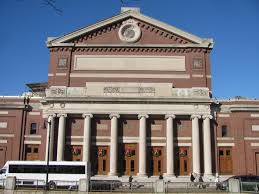On Thursday, March 1st, 2018, Todd Cole, music and choral arts teacher at Malden High, took his Music Theory class, to see the Boston Symphonic Orchestra at Symphony Hall.
During the trip, we were seated in the first fourth and fifth rows on the right side of the stage and treated to three separate pieces created by three different composers.
The interior of Symphony Hall is full of intricate art and carvings and possesses wonderful acoustics. After being seated by the staff of the establishment, we were given a small amount of background information on the musicians and the music they were about to play for us.

The event was considered an open rehearsal and the only others sitting in the seats were students from other schools. Although titled a “rehearsal”, the performance was nothing less than brilliant. The orchestra played the entirety of each of the three pieces, then, after finishing each piece, the conductor would tell them to go back and replay parts that he felt could have been played better or differently, and that’s the only part where the “rehearsal” aspect came into play. Otherwise, I would’ve considered it a full blown concert.
The first two pieces played for us were “En Saga” by Jean Sibelius and “Jeux, Poème Dansé” by Claude Debussy. Both pieces were wonderful in their own special ways while, in my opinion and that of several others, “Jeux” was difficult to listen to, as it was a 16 minute song with no real home base or finality, therefore it was difficult to follow where the song was going.
Sibelius’ “En saga” fit a more traditional definition of “classical”. It was a very pretty piece with a definite “home” and repeating themes and the musicians played it exceptionally well. I have heard that song about a million times in the past couple of months, but even so, seeing it live was a truly magical experience. My classmates and I could not get the song out of our heads.
The real star of the show was a piece by John Adams called “Scheherazade.2”. This piece is a four movement, 50 minute long performance telling the story of a woman named Scheherazade from the collection of stories One Thousand and One Nights .
Essentially, the narrative tells the story of a king whose wife cheats on him, so he kills her. The king then proceeds to marry a new woman every night killing each one off the next day, as to prevent them from cheating on him. Scheherazade is a woman who marries the king and tells half of an amazing tale every night keeping the king from having her killed, as he would want to hear the rest of the story. Every night, for 1,001 nights, Scheherazade tells the king a new story until he eventually falls in love with her and no longer wishes to kill her off the next morning.
For such a complex tale, the musicians portrayed each movement with such clarity.
This specific composition, “Scheherazade.2” was created by John Adams for a certain solo violinist named Leila Josefowicz. So, in reality, that piece is her song, and during our stay at Symphony Hall, she came out as a special guest after the first two pieces to practice her own song.
Leila Josefowicz is not a member of the Boston Symphonic Orchestra, and yet Todd Cole, his music theory class, and I, got to see first hand an amazing violinist play a song created for specifically her. It was absolutely moving. In my opinion Leila Josefowicz was a definite rock-star.
Compared to Debussy’s “Jeux” which was only 16 minutes, “Scheherazade.2” was much easier to listen to, even at 50 minutes. Each movement had its own character and all the dissonance was constructed in such beautiful ways. The experience was truly amazing.
All together, the Boston Symphonic Orchestra is truly comprised of some of the best musicians in the world and the music they played for us was nothing short of extraordinary.
It was was such a pleasure to take part in one of their open rehearsals, and I hope to be able to get myself to a full show sometime in the future.




